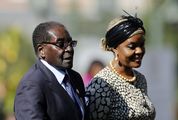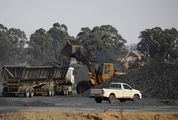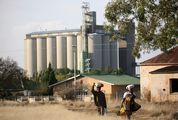HALF ART: Here’s something solid to hold on to, or is it?
by Chris Thurman,
2016-01-22 05:00:00.0
THE ground on which we stand is never quite as firm as we think it is. But there are times when it feels unshakeable and safe; and there are times when we are aware of crumbling rocks and shifting sands.
Life in SA seems increasingly precarious. The drought, the falling rand, double-digit inflation, creaking infrastructure, political instability, inept leadership, continued misspending of public funds ... the list is long.
Of course, while this sense of precarity may be experienced by those in the upper middle classes as something new, it is a long-standing reality for poor South Africans who face hunger and homelessness as constant threats. The absence of running water, electricity, rubbish collection and other municipal services is daily life in informal settlements, while in suburbia it is a temporary annoyance — and perhaps a worrying sign that these things may no longer be relied upon.
Those with the means to do so can buy themselves out of trouble: healthcare, education, telecommunications, transport and entertainment are all readily privatised (even electricity, to a degree, although water is tricky). If you’re well-off, your food budget can also be expanded. But when maize has to be imported, the cost of baseline staples (and most food) increases beyond what many people can afford.
The #FeesMustFall campaign has struck a national nerve because it collapses the tenuous divisions we have perpetuated between two very different worlds within our country. It insists on bringing into the world of privilege and comfort the perpetual anxiety, the precariousness, of poverty. It is a reminder that, just as our tertiary education system cannot continue with the current funding models, our "two economies" approach in every sector — in every facet of life in SA — cannot be sustained.
There is also something in the 24-hour news cycle that aggravates a feeling of instability. We’re voting this year, but none of the major parties has a consistent message. The African National Congress is hopelessly compromised and even its alliance partners are now turning against it. The Democratic Alliance is confused about how important it wants race to be. And the Economic Freedom Fighters (EFF)? Its enigmatic commander-in-chief aside, the party has a national chairman who will represent Gareth Cliff in his court action against M-Net even though the EFF insists that Cliff is a racist. They have a chief of staff whose messy corporate history emerged when he tried to claim R1.7m in shares from Nedbank — yet the EFF remains committed to an "anticapitalist" stance.
The moral and intellectual terrain is murky. Today’s hero is tomorrow’s villain. News stories morph and warp and twist. Students protest: good. Students threaten violence: bad. Universities call in private security forces: bad. Vice-chancellors explain why they feel they have no alternative: good — or is it? Then things take an absurd turn. The president gets his geographical facts wrong: bad. The Presidency formally acknowledges this oversight: good — or is it?
While open letters and press releases appear in their hundreds, and current affairs are impossibly ephemeral, and the future remains unpredictable but rather gloomy, my wife and I have taken the possibly imprudent decision to do some building at home. Our family is growing, so it’s a practical step, but it has also acquired a kind of symbolic value. Adding brick to brick feels like doing something that is, if not permanent, at least more enduring than the hearsay and guesswork that news analysis entails.
With this in mind, I made sure to catch African Modernism: Architecture of Independence, which is on at the Goethe-Institut in Johannesburg until the end of the month. This exhibition of photographic collages depicts some of the distinctive buildings constructed in Ghana, Senegal, Côte d’Ivoire, Kenya and Zambia at the time that these countries became independent.
I am no fan of the concrete bulk and curious geometries of modernist architecture, but it is presented here in historiographical terms: urban, national, material and ideological histories told through buildings.
In various states of repair and disrepair, of use and neglect, these buildings have both absorbed and resisted the ebb and flow of daily life in the cities around them. They are solid. For now, anyway.
• African Modernism: Architecture of Independence, Goethe-Institut, 119 Jan Smuts Ave, Johannesburg. Until January 29
Collage of La Pyramide, Abidjan, Côte D’Ivoire — on show at the Goethe-Institut. Picture: SUPPLIED
THE ground on which we stand is never quite as firm as we think it is. But there are times when it feels unshakeable and safe; and there are times when we are aware of crumbling rocks and shifting sands.
Life in SA seems increasingly precarious. The drought, the falling rand, double-digit inflation, creaking infrastructure, political instability, inept leadership, continued misspending of public funds ... the list is long.
Of course, while this sense of precarity may be experienced by those in the upper middle classes as something new, it is a long-standing reality for poor South Africans who face hunger and homelessness as constant threats. The absence of running water, electricity, rubbish collection and other municipal services is daily life in informal settlements, while in suburbia it is a temporary annoyance — and perhaps a worrying sign that these things may no longer be relied upon.
Those with the means to do so can buy themselves out of trouble: healthcare, education, telecommunications, transport and entertainment are all readily privatised (even electricity, to a degree, although water is tricky). If you’re well-off, your food budget can also be expanded. But when maize has to be imported, the cost of baseline staples (and most food) increases beyond what many people can afford.
The #FeesMustFall campaign has struck a national nerve because it collapses the tenuous divisions we have perpetuated between two very different worlds within our country. It insists on bringing into the world of privilege and comfort the perpetual anxiety, the precariousness, of poverty. It is a reminder that, just as our tertiary education system cannot continue with the current funding models, our "two economies" approach in every sector — in every facet of life in SA — cannot be sustained.
There is also something in the 24-hour news cycle that aggravates a feeling of instability. We’re voting this year, but none of the major parties has a consistent message. The African National Congress is hopelessly compromised and even its alliance partners are now turning against it. The Democratic Alliance is confused about how important it wants race to be. And the Economic Freedom Fighters (EFF)? Its enigmatic commander-in-chief aside, the party has a national chairman who will represent Gareth Cliff in his court action against M-Net even though the EFF insists that Cliff is a racist. They have a chief of staff whose messy corporate history emerged when he tried to claim R1.7m in shares from Nedbank — yet the EFF remains committed to an "anticapitalist" stance.
The moral and intellectual terrain is murky. Today’s hero is tomorrow’s villain. News stories morph and warp and twist. Students protest: good. Students threaten violence: bad. Universities call in private security forces: bad. Vice-chancellors explain why they feel they have no alternative: good — or is it? Then things take an absurd turn. The president gets his geographical facts wrong: bad. The Presidency formally acknowledges this oversight: good — or is it?
While open letters and press releases appear in their hundreds, and current affairs are impossibly ephemeral, and the future remains unpredictable but rather gloomy, my wife and I have taken the possibly imprudent decision to do some building at home. Our family is growing, so it’s a practical step, but it has also acquired a kind of symbolic value. Adding brick to brick feels like doing something that is, if not permanent, at least more enduring than the hearsay and guesswork that news analysis entails.
With this in mind, I made sure to catch African Modernism: Architecture of Independence, which is on at the Goethe-Institut in Johannesburg until the end of the month. This exhibition of photographic collages depicts some of the distinctive buildings constructed in Ghana, Senegal, Côte d’Ivoire, Kenya and Zambia at the time that these countries became independent.
I am no fan of the concrete bulk and curious geometries of modernist architecture, but it is presented here in historiographical terms: urban, national, material and ideological histories told through buildings.
In various states of repair and disrepair, of use and neglect, these buildings have both absorbed and resisted the ebb and flow of daily life in the cities around them. They are solid. For now, anyway.
• African Modernism: Architecture of Independence, Goethe-Institut, 119 Jan Smuts Ave, Johannesburg. Until January 29



















Change: 2.98%
Change: 3.39%
Change: 2.94%
Change: 3.00%
Change: 5.00%
Data supplied by Profile Data
Change: 0.00%
Change: 0.00%
Change: 2.98%
Change: 0.00%
Change: 0.00%
Data supplied by Profile Data
Change: 0.00%
Change: -0.01%
Change: 0.01%
Change: 0.00%
Change: -0.58%
Data supplied by Profile Data
Change: 0.00%
Change: 0.00%
Change: 0.00%
Change: 0.00%
Change: 0.00%
Data supplied by Profile Data